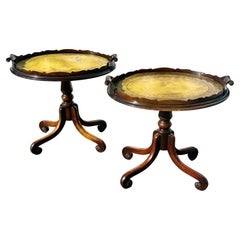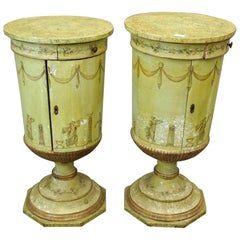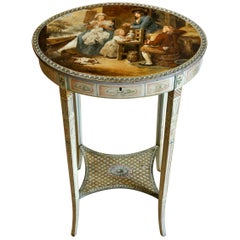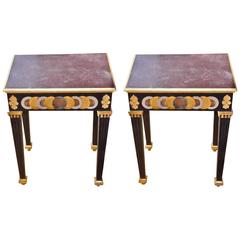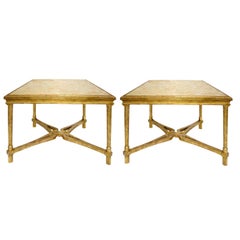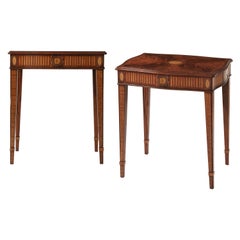Perim Lang Antiques End Tables
to
Height
to
Width
to
Depth
to
4
4
2
1
1
1
2
1
1
4
1
1
1
1
3
2
2
1
1
4
4
4
Pair of Regency Style Tray Top Side Tables
Located in Essex, MA
Pair of Chic Regency Style or Hollywood Regency Tray Top Side Tables. Trays Top attached to Mahogany Bases with Four Turned over Legs Ending in Rosettes. Trays with original yellow...
Category
Mid-20th Century English Regency End Tables
Materials
Leather, Mahogany
$3,800 / set
Pair of Venetian Paint Urn Form Bedside or End Cabinets
Located in Essex, MA
Pair of Venetian painted urn form cabinets. Neoclassical figures and festoons surrounding a charming urn shape. Storage cabinet and drawer.
Category
Antique Late 19th Century Italian Neoclassical Commodes and Chests of Dr...
Materials
Pine
Period English Robert Adam Painted Neoclassical Work Table, circa 1770
By Robert Adam
Located in Essex, MA
Period and original Adam style painted work or sewing table
-- Neoclassical
-- Hogarth type painting on top lid and a narrative work on the inside
-- Amazing condition of paint...
Category
Antique Mid-18th Century English Adam Style End Tables
Materials
Beech
Pair of Faux Porphyry Painted Side Tables
Located in Essex, MA
Wonderful pair of side tables
Designer created, artist painted
Neoclassical
Faux porphyry tops.
Category
Late 20th Century American Neoclassical End Tables
Materials
Maple
$6,800 / set
Related Items
Pair of Regency Style Giltwood Designer Marbella Side Tables by Randy Esada
Located in LOS ANGELES, CA
Pair of Regency style giltwood designer Marbella side tables by Randy Esada.
Note: Custom orders require a deposit and cannot be canceled. All custom order deposits are non-refund...
Category
21st Century and Contemporary American Regency End Tables
Materials
Marble
$6,840
H 22 in W 22 in D 22 in
Pair of Hepplewhite Style Side Tables
Located in Westwood, NJ
Pair of English George III Hepplewhite style flame mahogany, Morado banded and sycamore veneered lamp table with fine double stringing, the serpentine top above a fluted veneered...
Category
21st Century and Contemporary Vietnamese Hepplewhite End Tables
Materials
Mahogany
Pair of Jacobean Style Side Tables
Located in Westwood, NJ
A Jacobean style rectangular one-drawer side table with an ogee top edge, in our distressed rustic country wood tone with natural highlights, with a hand-rubbed satin finish with a b...
Category
21st Century and Contemporary Vietnamese Jacobean End Tables
Materials
Wood
Pair of Regency Style Side Tables
Located in Westwood, NJ
Regency style side table with a wooden gallery top, molded edge, with a pull-out slide about a lower shelf with drawer and turned legs all in ...
Category
21st Century and Contemporary Vietnamese Regency End Tables
Materials
Wood
Pair of Venetian Neoclassical Hand Painted Commodes
Located in London, Park Royal
A pair of Venetian commodes, hand painted in the Neoclassical style featuring fine scroll work in hues of brick pinks, yellow ochres, olive g...
Category
Antique Late 19th Century Italian Neoclassical Commodes and Chests of Dr...
Materials
Wood
19th Century English Black Japanned Work Table
Located in New York, NY
With gilt chinoiserie decoration of court figures in a mountainous landscape on a black ground; the hinged rectangular top with canted corner opening to a paper-lined interior; raise...
Category
Antique Mid-18th Century English Sheraton End Tables
Materials
Wood
Fine English Inlaid Mahogany Hepplewhite Period Pembroke Table with Drawer
Located in San Francisco, CA
A fine English inlaid mahogany Hepplewhite period oval pembroke table of typical form, the line inlaid crossbanded top with 2 drop sides similarly decorated, over a single drawer, su...
Category
Antique Late 18th Century English Hepplewhite End Tables
Materials
Brass
$2,850
H 29.5 in W 21.5 in D 30.5 in
Hollywood Regency Style Side Table or End Table with Mirrored Top
Located in Miami, FL
A fine quality vintage polished bronze side table or end table.
This Hollywood Regency style table has a mirrored top that would add flare to display your favorite vase of flowers, ...
Category
Late 20th Century American Hollywood Regency Side Tables
Materials
Bronze
$1,500 Sale Price
31% Off
H 32 in Dm 22.5 in
Adam Demilune Console Table
By Robert Adam
Located in Greenwich, CT
Very fine George III demilune console table, in the manner of Robert Adam, the later marble top over lamb's tongue carved molding over frieze d...
Category
Antique 1770s English Adam Style Console Tables
Materials
Marble
Italian Art Deco Period Parquetry Table circa 1930s
Located in Forney, TX
A magnificent period Italian Art Deco Moderne elaborately inlaid table. circa 1930
Finely hand-crafted in Italy, most likely the Sorrento - Naples region of Southern Italy, featuri...
Category
Mid-20th Century Italian Art Deco End Tables
Materials
Wood, Fruitwood, Maple, Walnut
18th Century French Louis XVI Neoclassical Painted End Table
Located in Dallas, TX
18th century French Louis XVI neoclassical painted end table is a classic example of talented rural artisans emulating the styles of the court. Louis XVI is known for reviving the cl...
Category
Antique Late 18th Century French Louis XVI End Tables
Materials
Brass
Pair of Painted Bedside Chest of Drawers
Located in Leamington Spa, Warwickshire
Pair of custom made small painted pine bedside chest of drawers.
Dimensions
26.5 inches (67 cms) Wide
15.5 inches (39 cms) Deep
28 i...
Category
21st Century and Contemporary Commodes and Chests of Drawers
Materials
Pine
